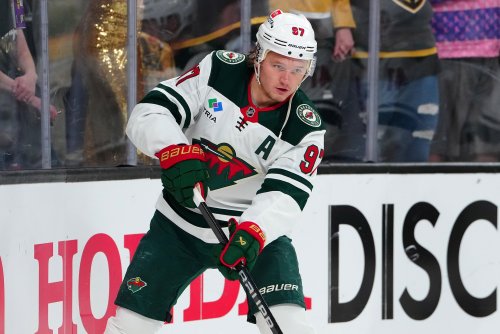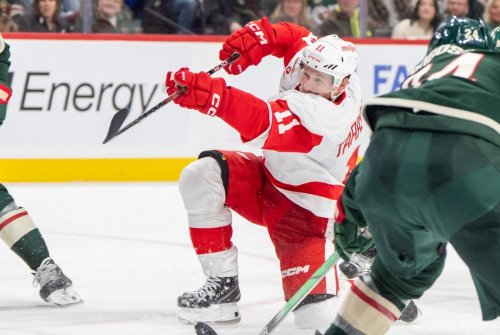
Most analytics “believers” would consider the Vegas Golden Knights to possess something like the fifth-best offense in the NHL. According to MoneyPuck.com, they have the following 5-on-5 stats:
These indicate a team that’s able to possess the puck constantly, and has the confidence to convert this possession into a high volume of shots. Not only do they create a high volume of shots, but they look for quality shots - this is why their xG for per 60 is so high. It’s also why they give the puck away so often: they are constantly in possession and looking to put the puck in dangerous spots - while they often turn it over, they also often convert. Their goal-scoring rate is sustainable too, because it’s shadowed by every stable and predictive metric of scoring chance quantity (Corsi-for rate) and value (xG-for rate).
Vegas’s Forward Lines
So, how does this team do it? In terms of personnel, Vegas has two lines that are absolutely set in stone: a trio of Jonathan Marchessault, William Karlsson, and Reilly Smith, in addition to the top line of Max Pacioretty, Chandler Stephenson, and two-way stalwart Mark Stone. They’ve played the second and sixth-most minutes respectively, of all forward combinations in the NHL.
Of line combinations that have played more than 200 minutes, these groups have generated 2.9 and 2.84 xGoals per 60 minutes, although this stat is buoyed by their powerplay time together. They’ve generated xGF% metrics of 53% and 57%, meaning that they’ve produced more quality scoring opportunities than they allow defensively.
The only weakness of this top-six forward group is that Mark Stone’s first line is only average defensively, and the second line is leaky defensively. The good news about this is that they “defend” by possessing the puck and keeping it out of their defensive zone, rather than “playing defense” in the traditional sense. William Karlsson’s line has a similar weakness. The Wild play a similar possession style of hockey, so if they can even the odds, the top six forward group in Vegas could be vulnerable to counter-attack.
After this top six, the lineup gets muddier in terms of sample sizes - the next-most common lines deployed by Vegas have been Carrier-Nosek-Reaves and Glass-Roy-Tuch. Nosek and Reaves are both day-to-day with undisclosed injuries, but my best guess is that both will be good to go for playoffs - especially Reaves.
Assuming both play, let’s preview the bottom-six. Glass-Roy-Tuch is a solid third line that can score reasonably well while taking on checking responsibilities - they’re like a diet Greenway-Eriksson Ek-Foligno line. Their xG% is 58%, tops on the team aside from Nosek-Roy-Tuch - in other words, Nicolas Roy and Alex Tuch play well together. The Cody Glass version plays the best defense of any of Vegas’s lines, and the Nosek version scores way more goals, but also give a lot up defensively. It’s important to note that both of these combinations have played a small sample size this season, especially Nosek-Roy-Tuch, so these analytical conclusions must be taken with a grain of salt.
Carrier-Nosek-Reaves has played decent hockey from an analytical perspective with a 50 xGF%, and you have to assume that Reaves’s penchant for pissing off his opponents plays a positive factor that can’t be quantified. This is the leakiest line that Vegas has by xGA per 60, so expect the Wild to put Fiala or Kaprizov on the Xcel Energy Center ice when this line plays, unless Reaves scares them off.
For a reference of other players who may slot in for injuries, Vegas’s players are shown below:
Vegas’ Forwards
Because we, at Hockey Wilderness, celebrate our individual differences.
All stats that follow are 5-on-5 metrics.
Vegas has a deep forward lineup that loves to create high-danger shots. The Knights’ forwards are led in goals per 60 minutes by Pacioretty (1.13), Nosek (1.11), Stone (1.08), Marchessault (1.01), Tuch (.96), and Stephenson (.92). Give each of these guys 15:00 per night, and the Knights should score 1.55 goals from their top six shooters every night, before accounting for the power play, the other 6 forwards, or the other six defensemen.
The leaders in xG per 60, which indicates players who are on the end of great chances, are as follows: Nosek (.98), Tuch (.97), Carrier (.94), Pacioretty (.93), Kolesar (.88), and Marchessault (.85) - sound familiar? While these numbers are lower than the actual goals/60, you would expect that the shooting talent of these guys, plus the passing talent of Mark Stone, to elevate actual goals above expected goals.
MoneyPuck.com estimates the shooting talent of players once they reach a certain playing time threshold. They believe that the following players have shots that are x percent above average: Stone (15%), Pacioretty (12%), Stephenson (10%), Marchessault (8%), Karlsson (7%), and Smith (4%). It’s important to note that this isn’t their expected shooting percentage, but the amount that they elevate the value of a shot above average. Tuch, Glass, and Kolesar will likely join this positive shot-value group once they reach the necessary threshold as well. So when you see these guys get on the end of a shot, watch out.
The team has many players who are comfortable generating offense at the net - the share of xG on shots after rebounds is extremely high for Nosek, Kolesar, Reaves, Karlsson, Marchessault, and pretty high for Carrier, Glass, Tuch, and even Stone. Don’t expect a soft game from Vegas, even if they do have skill - they know the ugly goals count the same as the pretty ones.
Home Matchups
So, how should the Wild lineup counter these fearsome forwards?
Games three and four will be played at the Xcel energy center, where Minnesota will have the advantage of “last change.” What this means is that after Vegas puts its five skaters onto the ice for any faceoff, Minnesota will choose their personnel. This allows head coach Dean Evason to counteract Vegas’s line combinations.
Remember that Vegas’s top two lines are susceptible to counter-attacking, as long as you can get the puck back from their strong possession play. Another option is to deploy defensemen who can prevent these lines from penetrating to the high-danger areas which this team loves to explore. Minnesota has the personnel to do this very effectively. If I had power over the Wild bench, I’d deploy personnel like this:
Road Matchups
Starting on the road, the Wild will be able to dictate the ice time of their own lines, while Vegas will dictate the opponents in response. Evason has a few options on the road:
I’m exaggerating, but it shows a way that the Wild can take advantage of the perceived disadvantage of Vegas having last change - we get to choose how many minutes each of those matchups play. While it would limit Fiala and/or Kaprizov’s ice time (it’s unlikely that Vegas’s line-matchups would be favorable for both of Minnesota’s superstars), you get a better chance to produce scoring chances. If Dean Evason really does deserve the Jack Adams buzz he’s been receiving of late, then his lineup should make it so hard for Vegas to game-plan against us that the Wild have one or two favorable matchups, especially near the top of the lineup.
Meet the Vegas Power Play
Vegas has a decent power play, but the real danger is that they get to use it so often often. At they’ve played the ninth-most power play minutes in the league. This squares with their identity as a puck possession team, and allows them to become a well-oiled machine as they prod opposing PK units again and again, finding tactical weaknesses and wearing down their stamina.
Vegas has had 12 players join its powerplay for more than 60 minutes of PP time this season: Stone, Karlsson, Marchessault, Pacioretty, and defenseman Shea Theodore with the most minutes. Cody Glass and defenseman Alex Pietrangelo have only played 27 and 41 games respectively, but have played often on the powerplay when healthy. Also playing often are Marchessault, Smith, Stephenson, and Tuch. These ten players seem to be Vegas’s primary options on the PP, with center Mattias Janmark and defenseman Alec Martinez filling in as necessary.
With only two defensemen spread across two power play units, it would appear that Vegas often utilizes four forwards on the power play, using a defenseman as a distributor at the point. Given that all but Tuch and Janmark have positive-value shooting, I’d say this is a sensible approach.
On the other hand, Vegas has only scored at average rates this season in spite of its shooting talent. The Knights have the 22nd-highest power play goal scoring rate in the league on the 14th-most power play expected goals per 60. That’s downright average. They have the 20th-highest percentage of power play shot-attempts blocked, the 14th-most shot attempts that miss the net. If the Wild PK can get in the way of Vegas’s shooters, there’s a very good chance that the Knights’ PP stays bad.
Think you could write a story like this? Hockey Wilderness wants you to develop your voice, find an audience, and we'll pay you to do it. Just fill out this form.








Recommended Comments
There are no comments to display.
Join the conversation
You can post now and register later. If you have an account, sign in now to post with your account.
Note: Your post will require moderator approval before it will be visible.